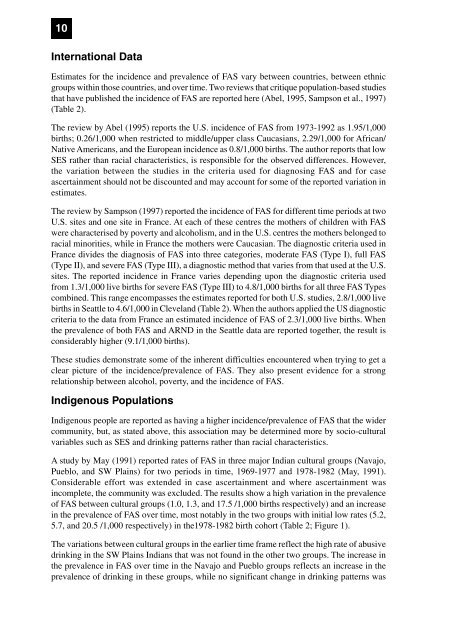Fetal Alcohol Syndrome A literature review - Department of Health ...
Fetal Alcohol Syndrome A literature review - Department of Health ...
Fetal Alcohol Syndrome A literature review - Department of Health ...
Create successful ePaper yourself
Turn your PDF publications into a flip-book with our unique Google optimized e-Paper software.
10<br />
International Data<br />
Estimates for the incidence and prevalence <strong>of</strong> FAS vary between countries, between ethnic<br />
groups within those countries, and over time. Two <strong>review</strong>s that critique population-based studies<br />
that have published the incidence <strong>of</strong> FAS are reported here (Abel, 1995, Sampson et al., 1997)<br />
(Table 2).<br />
The <strong>review</strong> by Abel (1995) reports the U.S. incidence <strong>of</strong> FAS from 1973-1992 as 1.95/1,000<br />
births; 0.26/1,000 when restricted to middle/upper class Caucasians, 2.29/1,000 for African/<br />
Native Americans, and the European incidence as 0.8/1,000 births. The author reports that low<br />
SES rather than racial characteristics, is responsible for the observed differences. However,<br />
the variation between the studies in the criteria used for diagnosing FAS and for case<br />
ascertainment should not be discounted and may account for some <strong>of</strong> the reported variation in<br />
estimates.<br />
The <strong>review</strong> by Sampson (1997) reported the incidence <strong>of</strong> FAS for different time periods at two<br />
U.S. sites and one site in France. At each <strong>of</strong> these centres the mothers <strong>of</strong> children with FAS<br />
were characterised by poverty and alcoholism, and in the U.S. centres the mothers belonged to<br />
racial minorities, while in France the mothers were Caucasian. The diagnostic criteria used in<br />
France divides the diagnosis <strong>of</strong> FAS into three categories, moderate FAS (Type I), full FAS<br />
(Type II), and severe FAS (Type III), a diagnostic method that varies from that used at the U.S.<br />
sites. The reported incidence in France varies depending upon the diagnostic criteria used<br />
from 1.3/1,000 live births for severe FAS (Type III) to 4.8/1,000 births for all three FAS Types<br />
combined. This range encompasses the estimates reported for both U.S. studies, 2.8/1,000 live<br />
births in Seattle to 4.6/1,000 in Cleveland (Table 2). When the authors applied the US diagnostic<br />
criteria to the data from France an estimated incidence <strong>of</strong> FAS <strong>of</strong> 2.3/1,000 live births. When<br />
the prevalence <strong>of</strong> both FAS and ARND in the Seattle data are reported together, the result is<br />
considerably higher (9.1/1,000 births).<br />
These studies demonstrate some <strong>of</strong> the inherent difficulties encountered when trying to get a<br />
clear picture <strong>of</strong> the incidence/prevalence <strong>of</strong> FAS. They also present evidence for a strong<br />
relationship between alcohol, poverty, and the incidence <strong>of</strong> FAS.<br />
Indigenous Populations<br />
Indigenous people are reported as having a higher incidence/prevalence <strong>of</strong> FAS that the wider<br />
community, but, as stated above, this association may be determined more by socio-cultural<br />
variables such as SES and drinking patterns rather than racial characteristics.<br />
A study by May (1991) reported rates <strong>of</strong> FAS in three major Indian cultural groups (Navajo,<br />
Pueblo, and SW Plains) for two periods in time, 1969-1977 and 1978-1982 (May, 1991).<br />
Considerable effort was extended in case ascertainment and where ascertainment was<br />
incomplete, the community was excluded. The results show a high variation in the prevalence<br />
<strong>of</strong> FAS between cultural groups (1.0, 1.3, and 17.5 /1,000 births respectively) and an increase<br />
in the prevalence <strong>of</strong> FAS over time, most notably in the two groups with initial low rates (5.2,<br />
5.7, and 20.5 /1,000 respectively) in the1978-1982 birth cohort (Table 2; Figure 1).<br />
The variations between cultural groups in the earlier time frame reflect the high rate <strong>of</strong> abusive<br />
drinking in the SW Plains Indians that was not found in the other two groups. The increase in<br />
the prevalence in FAS over time in the Navajo and Pueblo groups reflects an increase in the<br />
prevalence <strong>of</strong> drinking in these groups, while no significant change in drinking patterns was

















